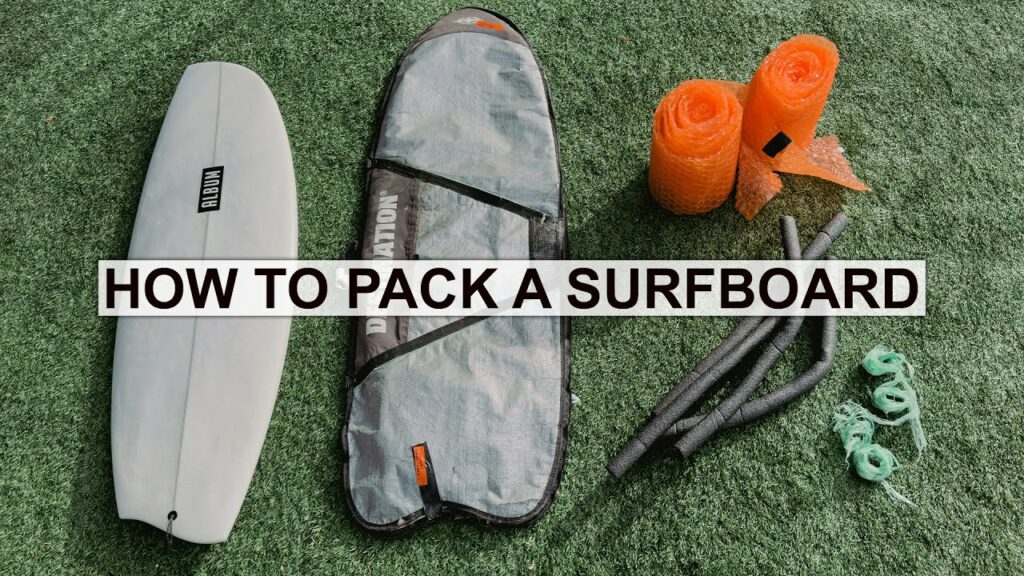Mastering the Waves: A Comprehensive Guide on How to Pack a Surfboard for Travel

Introduction:
Embarking on a surf adventure to a distant shoreline or exploring new breaks is an exhilarating experience for wave enthusiasts. However, the challenge lies in safely transporting your prized surfboard to ensure it reaches its destination unscathed. Packing a surfboard for travel requires careful consideration, proper materials, and attention to detail. In this comprehensive guide, we’ll delve into the intricacies of packing a surfboard for travel, offering valuable tips and step-by-step instructions to safeguard your board and make your surfing expedition a smooth ride.
Section 1: Choosing the Right Travel Bag
1.1 Types of Surfboard Bags:
Selecting the appropriate surfboard bag is crucial to protect your board during transit. Consider options such as:
- Day Bag: Ideal for short-distance trips and provides minimal padding.
- Coffin Bag: Offers extensive padding and protection, suitable for air travel or long-distance journeys.
- Socks and Wraps: Lightweight options for short trips, providing minimal protection against scratches and dings.
1.2 Size and Fit:
Choose a bag that accommodates the dimensions of your surfboard. Ensure there’s enough space for additional padding without excessive looseness, reducing the risk of damage during transport.
1.3 Quality and Durability:
Invest in a high-quality bag made from durable materials. Features like reinforced zippers, padded interiors, and robust stitching enhance the bag’s longevity and protection capabilities.
Section 2: Preparing Your Surfboard
2.1 Clean Your Surfboard:
Thoroughly clean your surfboard, removing any wax, sand, or debris. Clean boards are easier to inspect for damage, and removing wax prevents it from melting during transit.
2.2 Inspect for Damage:
Conduct a meticulous inspection of your surfboard, checking for any existing dings, cracks, or delaminations. Repair any damage before packing to prevent further issues during travel.
2.3 Remove Fins and Leash:
Take off the fins and detach the leash to reduce the risk of breakage and provide a more streamlined shape for packing. Place fins in a protective case or wrap them securely.
Section 3: Padding and Protection
3.1 Nose and Tail Protection:
Use foam padding or pool noodles to protect the nose and tail of your surfboard. These vulnerable areas are more prone to damage, and extra padding provides an added layer of protection.
3.2 Rail Protection:
Wrap the rails of your surfboard with bubble wrap or pipe insulation. Secure the padding with tape to shield the board’s edges from impacts and dings.
3.3 Nose and Tail Guards:
Consider adding specialized nose and tail guards for additional protection. These guards, made from materials like foam or plastic, shield the ends of your surfboard from potential damage.
Section 4: Packing Your Surfboard
4.1 Positioning in the Bag:
Place your surfboard in the bag with the deck facing down. Ensure the fins align with the designated fin slots or areas within the bag to prevent unnecessary pressure on the fins.
4.2 Nose and Tail First:
Insert the nose of the surfboard into the bag first, followed by the tail. This positioning minimizes stress on the fins and aligns the board with the natural flow of water, reducing the risk of damage.
4.3 Utilize Board Separators:
If your bag includes board separators, use them to create a protective barrier between multiple surfboards. This prevents boards from rubbing against each other and causing scratches.
Section 5: Securing the Board in the Bag
5.1 Tightening Straps:
Secure the surfboard inside the bag by tightening any internal straps or Velcro fastenings. Ensure the board is snug but not overly compressed, maintaining a balance between security and preventing excessive pressure.
5.2 Padding Around the Board:
Add extra padding around the surfboard within the bag. This can include towels, clothes, or additional bubble wrap to fill any voids and provide cushioning against potential impacts.
5.3 Zipper Alignment:
Carefully zip the bag, ensuring the zipper aligns smoothly. Avoid forcing the zipper, as this can cause damage. Some bags come with corrosion-resistant zippers, particularly beneficial for air travel.
Section 6: Additional Considerations for Air Travel
6.1 Know Airline Policies:
Before heading to the airport, familiarize yourself with the specific policies of the airline regarding surfboard transport. Check for any additional fees, size restrictions, or requirements for packing.
6.2 Reinforce Fragile Areas:
For air travel, consider reinforcing fragile areas such as the nose, tail, and fins with extra padding. Airlines may be less gentle with baggage, and reinforced protection adds an extra layer of security.
6.3 Remove Wax and Traction Pads:
In hot climates, wax can melt and cause a mess. Consider removing excess wax and traction pads to prevent damage and keep your surfboard clean during air travel.
Section 7: Labeling and Identification
7.1 Labeling the Bag:
Clearly label your surfboard bag with your contact information. Attach a durable luggage tag or use a waterproof marker to write your details directly on the bag.
7.2 Identification Inside the Bag:
Place a card inside the bag with your name, contact information, and destination address. This ensures that even if the external tag is damaged or removed, your surfboard can still be identified.
7.3 Photograph Your Setup:
Take photos of your packed surfboard and bag, documenting the condition and setup. In case of any issues during transport, these photos can serve as valuable evidence.
Section 8: Unpacking and Post-Travel Care
8.1 Unpacking with Care:
Upon reaching your destination, unpack your surfboard with care. Remove all padding and inspect the board for any signs of damage during transit.
8.2 Immediate Repairs:
If you notice any new dings or damage, address them promptly. Immediate repairs prevent further complications and ensure your surfboard is in optimal condition for your surfing adventures.
8.3 Storing the Bag:
Store your surfboard bag in a cool, dry place when not in use. Avoid exposing it to direct sunlight for extended periods, as this can cause material degradation.
Conclusion:
Packing a surfboard for travel is a meticulous process that involves careful preparation, attention to detail, and a commitment to safeguarding your prized possession. By choosing the right travel bag, preparing your surfboard, providing adequate padding and protection, positioning and securing the board within the bag, considering additional measures for air travel, labeling and identifying your bag, and practicing post-travel care, you can ensure that your surfboard arrives at its destination ready for action. Remember, a well-packed surfboard is not just a board; it’s a key to unlocking thrilling adventures and riding the waves in new and exciting locations. May your travels be smooth, and the waves be endless!




